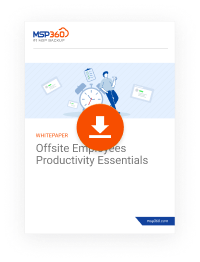It’s no secret that hiring – let alone retaining – talented IT professionals is a real challenge. It was hard before the pandemic, when 42% of businesses reported sourcing as their top difficulty in recruiting for IT roles. But it has become even harder following the pandemic and the “Great Resignation,” which led to a surge in the number of tech workers who are leaving their jobs for other companies – or, in some cases, even exiting the industry completely.
The question for MSPs and other businesses who need tech talent is how to cope with employee acquisition and retention challenges. While there are no simple answers, there are strategies that can help to staunch the tech brain-drain that many companies face today.
Keep reading for insights on what it takes to hire and retain the right technology talent in the post-pandemic world, especially if you’re an MSP who depends centrally on having qualified IT practitioners on staff to deliver managed services.
IT Talent Acquisition and Retention Challenges for MSPs
If you’re an MSP who is having trouble finding, hiring and keeping IT workers, it’s likely due to one of the following challenges:
- Competition from other companies trying to hire the same employees (or “poach” them from your business after you’ve hired them).
- A perception among workers that your salary and bonus incentives are too low.
- Limited promotion and career development opportunities at your company.
- High levels of work-related stress.
- A feeling that there is a lack of support for workers from management.
These were all among the top factors identified by an ISACA survey as reasons tech employees leave their jobs or choose not to accept job offers in the first place.
VMware’s latest Global Incident Response Threat Report adds another important data point. It found that 51% of cybersecurity professionals identify as being burned out. That survey looked only at cybersecurity workers, not IT workers in general, but it’s likely that feelings of burnout underlie many of the IT hiring challenges that companies face today across the board.
Further reading Why MSPs Need to Prioritize Employee Retention Strategies Now More Than Ever
Solutions for IT Hiring and Retention
While the factors behind tech employees’ reluctance to accept and keep jobs seem clear enough, the solutions are not necessarily so. To address the issues and retain top tech talent, businesses need to think a bit creatively by embracing practices like the following.
Invest in Skills Development
A Trellix study found that 85% of workers believe it is “extremely important” for their employers to help them develop new skills. Learning new technical skills helps employees feel valued at their jobs and keeps them engaged.
For this reason, investing in technical skills development programs is a must for MSPs that want to win the IT hiring and retention game today. Instead of expecting workers to know everything they need to know from their date of hire, offer them training and opportunity to gain new skills. You could also pay for them to take certification classes and exams.
Read this free whitepaper to learn more about:
- How to move your operations out of the office
- Security considerations for remote workers
- Best practices and tools
Build Diverse Workforces
The Trellix study also found that the strong majority of tech workers want to see more demographic diversity within the workplace. This is likely a reflection of a desire by IT professionals to feel recognized and valued by management.
The lesson here is simple enough: Strive to hire diverse workers. The practice will not only help you to increase the diversity of your workforce, but it may also help you to retain employees of all backgrounds who, on the whole, expect greater diversity among their colleagues.
Consider Degree-Blind Hiring
One way to increase tech workforce diversity is to embrace so-called degree-blind hiring. Degree-blind hiring means ignoring candidates’ educational background and other formal credentials. Instead, you focus solely on the skills that they can demonstrate, regardless of how they obtained them.
Degree-blind hiring helps to broaden your IT job applicant pool, making it easier to find tech talent. It’s also likely to create a more diverse workforce because it allows you to recruit qualified candidates who hail from backgrounds where traditional college educations were inaccessible.
Offer Performance-Based Financial Incentives
As noted above, perceptions of low pay are a leading reasons IT workers leave jobs.
While simply increasing salary may be one way to address this challenge, it’s not necessarily the most effective, because it’s costly and it still doesn’t guarantee that you’ll retain employees. A better approach most times is to offer performance-based financial incentives, such as bonuses that are tied to employees’ ability to meet specific targets. If your team meets SLI rates above 95% in a given quarter, for example, you could pay them extra.
By tying financial incentives to performance, you reinforce the idea that pay is linked to engagement, and you help high-performing employees to feel more recognized by management. That’s a wiser investment of your financial resources than simply issuing across-the-board salary increases.
Conclusion
In the age of the Great Resignation, smart MSPs aren’t sitting idly by, waiting for tech hiring and retention challenges to pass. They’re being proactive about recruiting and keeping talented workers in order to ensure they have the right staff on hand to keep serving clients and expanding into new types of managed services.







